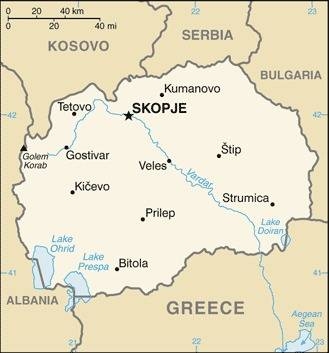100 North Macedonia

A yellow sun (the Sun of Liberty) with eight broadening rays extending to the edges of the red field. The red and yellow colors have long been associated with Macedonia.
Flag courtesy of the CIA World Factbook

Map courtesy of the CIA World Factbook

Mount Korab, the highest mountain in North Macedonia.
Government
According to Britannica, the 1991 constitution of the newly independent republic established a republican assembly, called the Sobranie, consisting of a single chamber of 120 seats. There is an explicit separation of powers between the legislature, the judiciary, and the executive. The prime minister and cabinet ministers, for example, do not have seats in the assembly. The executive, under the prime minister, is the most powerful branch, with the legislature and judiciary acting principally as checks and balances to the government’s activity. The president, who is elected to a five-year term, serves principally as a symbolic head of state and is the commander in chief of the armed forces; a president may serve no more than two terms. In 2001 the constitution was amended to include a number of provisions aimed at protecting the rights of the Albanian minority.
The republic is divided into 80 opštini (municipalities), to which are delegated many important social, judicial, and economic functions.
The legal system of North Macedonia is grounded in civil law. The judicial branch comprises basic and appellate courts, the Supreme Court, the Republican Judicial Council, and the Constitutional Court. The judges of the Constitutional Court are elected by the Sobranie.
Civil Aviation Agency (CAA)
The Civil Aviation Agency (CAA) is organized as an aviation authority of the Republic of North Macedonia and its organizational structure provides efficient and timely execution of the safety regulatory functions described in ICAO Annex 19 and Doc.9734 (Safety Oversight System) as well as the other functions related to security oversight, economic oversight, air traffic rights etc. The main bodies of the CAA are the Management Board and the Director General. The Management Board is appointed by the Assembly of the Republic of North Macedonia. The Director General is appointed by the Management Board.
Airspace
SkyVector – Google Maps – ADS-B Exchange
ICAO countries publish an Aeronautical Information Publication (AIP). This document is divided into three parts: General (GEN), En Route (ENR) and Aerodromes (AD). ENR 1.4 details the types of airspace classes they chose to adopt from classes A through G.
Drone Regulations
Drone Laws – Regulation on unmanned aircraft – No. 115/24
32019R0945 (Chapters III, IV and the Annex)
32019R0947
32021R0664
Advanced Air Mobility (AAM) Regulations & Policies
None found by the author.
However, should you, the reader, happen to stumble across something to the contrary, please email the author at FISHE5CA@erau.edu and you may be mentioned in the ACKNOWLEDGEMENTS section of this book by way of thanks for contributing to this free eBook!
Advanced Air Mobility (AAM) News
None found by the author.
However, should you, the reader, happen to stumble across something to the contrary, please email the author at FISHE5CA@erau.edu and you may be mentioned in the ACKNOWLEDGEMENTS section of this book by way of thanks for contributing to this free eBook!
Short Essay Questions
Scenario-Based Question
You have been hired by a Drone Startup Company. Your boss has immediately assigned this job to you.
They need you to prepare a one-page memo detailing the legalities of using a drone to film Mount Korab in North Macedonia, pictured above.
They need you to mention any national laws and local ordinances.
They specifically want to know what airspace (insert pictures) you will be operating in and whether or not you need an airspace authorization.
Does it matter whether or not you are a citizen of the country?
Lastly, there is a bonus for you if, as you scroll through this chapter, you find any typos or broken links!
Short Essay Questions
- What are the drone categories?
- How is registration addressed?
- How is remote ID addressed?
- What are the model aircraft rules?
- What are the commercial drone rules?
- Are there waivers or exemptions to the rules? If so, for what?
- Would you share a link to an interactive airspace map?
- How is BVLOS addressed?
- How can you fly drones at night?
- How can you fly drones over people?
- Where do you find drone NOTAMs?
- What are the rules for drone maintenance?
- What are the rules for an SMS program?
- What are some unique rules not mentioned above?
- What are the C-UAS rules?
- What are the AAM rules?

